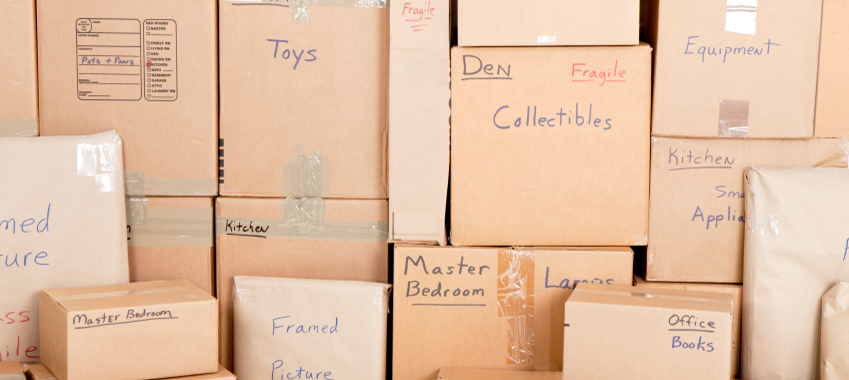With all the hassle and expense involved in moving, most people don’t have the time, energy, or inclination to think through their moving box strategy. Nor do most of us want to shell out cash for brand new moving boxes—making grocery store stockrooms a popular source of makeshift moving supplies. This can backfire, though, when cheap or free boxes prove difficult to move efficiently, come apart, or end up being full of grime and parasites.
While using suboptimal moving boxes may not seem like a huge issue, when it comes time to get your possessions from Point A to Point B with a minimum and damage, you’ll want to avoid the following common mistakes:
- Not packing everything: The most common mistake people make when moving is leaving a substantial number of items unboxed. While packing everything can be time consuming, your moving day will go much more smoothly if you take the time to contain all of your possessions. Straggling items can really complicate and bog down the loading and unloading process.
- Using garbage bags instead of boxes: Many moving companies will not move items packed in cheap plastic garbage bags. These are awkward to get from place to place (versus boxes, which can be stacked and wheeled on a dolly), and put your belongings at a much greater risk of damage. While garbage bags can effectively serve as garment bags, or be used to protect decorative items, it’s best to limit their use.
- Using banana boxes: If you’re looking for free moving boxes, try looking on Craigslist for actual moving boxes that someone else is looking to get rid of now that they’ve completed a move. Boxes that you might get from the grocery store are ideal for hauling groceries, but unideal for moving. They’re often not fully secure, can house pests like beetles, roaches, and spiders, and can be difficult to carry and load/unload efficiently.
- Using many different sizes of boxes: The more uniform the boxes you use, the easier your loading process will be. While there can be good reason to use a few different sizes and shapes of boxes—using wardrobe boxes for clothes, small boxes with handles for books, dish-pack boxes for plates and glassware, for example—if you can keep most of you boxes limited to one or two sizes, you’ll have a much easier time loading.
- Not securely closing boxes on all sides: Using open, crate-style boxes should be avoided at all costs, as they’re hard to stack and leave your possessions vulnerable to damage. In addition, you should securely tape top and bottom moving box seams rather than simply folding flaps in an interlocking pattern. This will help stabilize boxes and make them easy to stack.
- Using masking tape instead of packing tape: Closely related to the above, using the right kind of tape is crucial when it comes to avoiding exploding-box-related disasters. Masking tape is not designed to bear weight. Paper or plastic packing tape is specifically designed to hold boxes filled with heavy contents together, and you can dispense it with an inexpensive tape gun, streamlining your packing process.
- Making boxes too heavy: It can be tempting to cram each and every box full of as much stuff as possible, regardless of individual objects’ weight. Once you exceed about 25 pounds, however, standard moving boxes can become unwieldy. When packing, place heavy items on the bottom of each box, and then fill in with lighter items.
- Packing items loosely: While you don’t want to make boxes too heavy, you also don’t want to leave room for items to be bouncing around. Crumpled sheets of packing paper can be a cheap, effective way to easily fill extra space in your boxes.
- Packing boxes too full: If your boxes are straining at the seams, you’re just asking for trouble. Sometimes individual items are awkwardly shaped and don’t fit perfectly into the box sizes you have available. It’s always better to use a bigger box and fill it in with packing materials as needed, than to use a slightly too-small box. If none of your boxes are big enough to comfortably accommodate an item, just do what you can, and don’t put other items in the box.
- Not labeling boxes effectively: You don’t have to go crazy with a sophisticated inventory and/or color-coding system, but all boxes should be labelled with a minimum of what room they belong in. Use a Sharpie or thick marker, and label each side of every box, so that you can easily see which boxes belong where at a glance.
Once you’ve finished carefully packing your boxes, organize them into the order you want to load them into the moving truck, then take a final box count so that you can easily verify that all of you possessions have made it to your new location.


